
|

|
Accusplit II, and III (USA)
Today, the "Accusplit" name is a well known brand for timers, stopwatches, and pedometers. Their website claims they invented the first digital stopwatch in 1972. The large and bulky Accusplit I (not pictured), II, and III were certainly very early digital stopwatches using Panaplex displays and multiple ICs which predated the use of LSI (large scale integration) chips. Soon after these Accusplit stopwatches were made they were quickly rendered technologically outdated, as LED displays were introduced, and LSI chips made by National, Intersil, Mostek and others would take over the electronic clock and timer manufacturing industry. The chips made by Intersil for stopwatches would GREATLY reduce the size and cost of digital stopwatches in the coming years.
|
Heuer HL 430
Microsplit (Switzerland) This Richard Sapper designed
stopwatch is beautiful and elegant. The HL 520
version of this base case design is actually
featured in the Museum of Modern Art (MoMA) in New
York. Of all the stopwatches on this page, the 430
version we have is the most "pocket friendly", as
it is the most lightweight, thinnest, and lowest
profile non LCD display stopwatch we have
encountered so far.

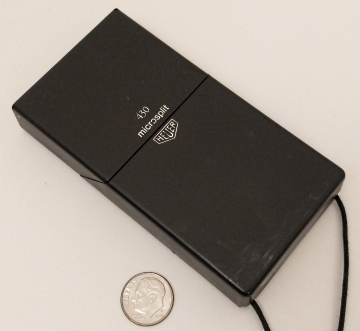

![]() Part of a series of "Microsplit" branded Heuer
stopwatches designed by the world renown German
industrial designer Richard Sapper. Other models in
the series included the HL
410/420/520/530.
Part of a series of "Microsplit" branded Heuer
stopwatches designed by the world renown German
industrial designer Richard Sapper. Other models in
the series included the HL
410/420/520/530.![]() Years produced: mid to late 1970's. The HL 430 was
introduced in 1976.
Years produced: mid to late 1970's. The HL 430 was
introduced in 1976.![]() Case is made in Switzerland with USA made
electronics using an Intersil ICM7045 28 pin
stopwatch timer chip.
Case is made in Switzerland with USA made
electronics using an Intersil ICM7045 28 pin
stopwatch timer chip.![]() Beautiful LED bubble lens displays shows Minutes,
Seconds, and Hundredths of Seconds
Beautiful LED bubble lens displays shows Minutes,
Seconds, and Hundredths of Seconds![]() Slide switch on left side for choosing between
Split and Taylor modes
Slide switch on left side for choosing between
Split and Taylor modes![]() Slide switch on the right side for off, continuous
time display, and momentary time display which is
used to conserve battery power
Slide switch on the right side for off, continuous
time display, and momentary time display which is
used to conserve battery power![]() Upper case front lifts up to function as a sun
shielding hood to create contrast for the LED
displays in bright sunlight
Upper case front lifts up to function as a sun
shielding hood to create contrast for the LED
displays in bright sunlight![]() Very unique sliding guard to protect accidental
pushing of both the start and stop pushbuttons.
This guard is shown in the photo below. It slides
to the the right to block the green start and red
stop buttons.
Very unique sliding guard to protect accidental
pushing of both the start and stop pushbuttons.
This guard is shown in the photo below. It slides
to the the right to block the green start and red
stop buttons.![]() Uses four "N" type batteries
Uses four "N" type batteries![]() Size: 4.15 x 2.15 x 0.70 inches
Size: 4.15 x 2.15 x 0.70 inches![]() Weight: 3.6 ounces with batteries
installed
Weight: 3.6 ounces with batteries
installed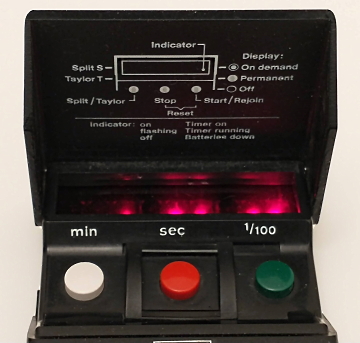
![]()
Kienzle
Chronostop (Germany) This stopwatch was quite an
unusual find! I like the two nice large slide
switches on the front for mode choice and power
on-off better than the Heuer which has much smaller
and harder to use switches on the sides. Also, the
sun hood cover is easier to lift up with small and
subtle extruded tabs on each side, and it clicks
into position at the perfect angle. This stopwatch
is easy and enjoyable to use.
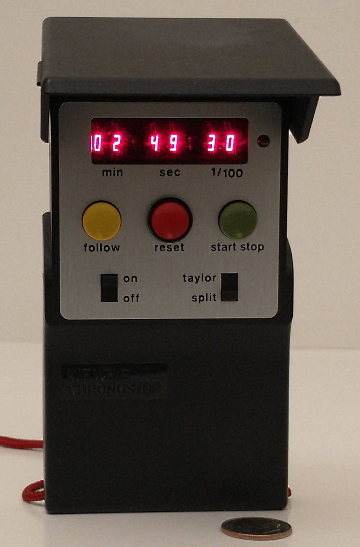

![]() Manufactured by Kienzle, the oldest watch maker in
Germany
Manufactured by Kienzle, the oldest watch maker in
Germany![]() Estimated years produced: mid 1970's
Estimated years produced: mid 1970's![]() Somewhat similar in styling to the Heuer
stopwatches above, but a little larger, not quite
as slick looking, BUT actually a little more
ergonomic
Somewhat similar in styling to the Heuer
stopwatches above, but a little larger, not quite
as slick looking, BUT actually a little more
ergonomic![]() 2.5 mm input jack on the left size for a 3 volt
input in lieu of using batteries. This is an
unusual feature we have never found on any other
handheld stopwatch.
2.5 mm input jack on the left size for a 3 volt
input in lieu of using batteries. This is an
unusual feature we have never found on any other
handheld stopwatch.![]() 2.5mm input jack on the right side for external
start-stop triggering. Again, this is a very unique
and unusual feature.
2.5mm input jack on the right side for external
start-stop triggering. Again, this is a very unique
and unusual feature.![]() Taylor and Split timing modes
Taylor and Split timing modes![]() Beautiful LED bubble lens displays for Minutes,
Seconds, and Hundredths of Seconds.
Beautiful LED bubble lens displays for Minutes,
Seconds, and Hundredths of Seconds.![]() It appears to be using an Intersil 24 pin ICM7015
stopwatch timer chip. This could not be verified
because the LED display is mounted right on top of
this chip, so it could not be read.
It appears to be using an Intersil 24 pin ICM7015
stopwatch timer chip. This could not be verified
because the LED display is mounted right on top of
this chip, so it could not be read.![]() Retractable hood on the case for shielding in
bright sun conditions
Retractable hood on the case for shielding in
bright sun conditions![]() Indented reset button to prevent accidental
resetting back to zero during timing operations. It
is a little difficult to press, but designed to be
this way!
Indented reset button to prevent accidental
resetting back to zero during timing operations. It
is a little difficult to press, but designed to be
this way!![]() Uses three "AA" size batteries
Uses three "AA" size batteries![]() Size: 4.45 x 2.65 x 0.95 inches
Size: 4.45 x 2.65 x 0.95 inches![]() Weight: 5.2 ounces with batteries
installed
Weight: 5.2 ounces with batteries
installed
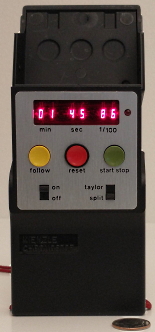
![]()
Intersil Cronus
1 Stopwatch (USA) 1 = Off, 2 = Standard
Start-Stop, 3 = Taylor/Sequential, 4 =
Split/Cumulative, 5 = Event/Time Out I really like the case design
and the superior ergonomics of the Cronus 1
stopwatch very much. It fits well in the hand and
the start-stop and display off buttons are handy
and easy to use. Intersil placed the reset button
on the front panel and it's quite small, with a
long plunger distance making it not so easy to
press accidentally. Introduced in late 1973, I
believe the Cronus 1 was chip manufacturer
Intersil's first venture into the LED stopwatch
market. With the use of their LSI chips and LED
bubble displays, they absolutely blew away the
heavy, bulky, and outdated Accusplit timers
introduced just a year earlier in 1972. The Intersil Conus 1 was
revolutionary in its time.


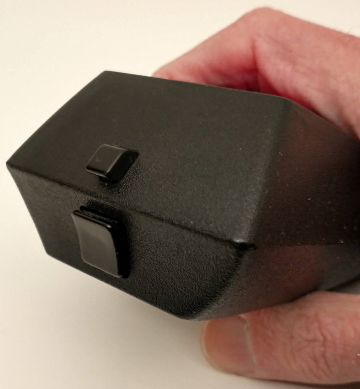
![]() Manufactured by Intersil Incorporated, in
Cupertino, CA. It appears to use the Intersil
ICM7045 28 pin stopwatch chip.
Manufactured by Intersil Incorporated, in
Cupertino, CA. It appears to use the Intersil
ICM7045 28 pin stopwatch chip.![]() Unique eight digit LED stopwatch timer with the
ability to time up to 24 hours.
Unique eight digit LED stopwatch timer with the
ability to time up to 24 hours.![]() LED bubble lens display shows Hours, Minutes,
Seconds, Hundredths of Seconds.
LED bubble lens display shows Hours, Minutes,
Seconds, Hundredths of Seconds.![]() Two buttons on the top. One for starting and
stopping the timer, and one that toggles between
display on and display off to conserve battery
power.
Two buttons on the top. One for starting and
stopping the timer, and one that toggles between
display on and display off to conserve battery
power.![]() Uses three AA NiCad batteries inside, charged by an
external AC wall adapter.
Uses three AA NiCad batteries inside, charged by an
external AC wall adapter.![]() Estimated years produced: 1973 - 1979
Estimated years produced: 1973 - 1979![]() Original Price: $195.00 (1973 US Dollars - a lot of
money!)
Original Price: $195.00 (1973 US Dollars - a lot of
money!)![]() Five function rotary switch for these modes:
Five function rotary switch for these modes:
![]() Dual function stopwatch timer AND digital clock
when not in use. The Cronus 1 could be purchased
with a nice wooden base to function as a digital
desk clock while charging and not in use as a
stopwatch. I have not figured out how to put this
timer into "clock mode" yet. But I believe it has
something to do with the wall adapter used for
charging the NiCad batteries inside.
Dual function stopwatch timer AND digital clock
when not in use. The Cronus 1 could be purchased
with a nice wooden base to function as a digital
desk clock while charging and not in use as a
stopwatch. I have not figured out how to put this
timer into "clock mode" yet. But I believe it has
something to do with the wall adapter used for
charging the NiCad batteries inside.![]() Size: 4.6 x 2.4 x 1.7 inches
Size: 4.6 x 2.4 x 1.7 inches![]() Weight: 6 ounces
Weight: 6 ounces
![]()
Cronus Total
Timer, Single Event, and Olympian Stopwatches
(USA) These stopwatches no longer
had any branding of Intersil on them. The Cronus
and Total Timer names were used by CPPI (see
above). I wonder if CPPI was a spin off or
subsidiary of Intersil. I cannot find any
information on this. But they certainly had
Intersil stopwatch chips in them. They are great
stopwatches, and extremely well built with nice
aesthetics and ergonomic design. Decades after they
were made, they are fairly easy to find and in good
working condition. But always ask about the battery
compartment and possible corrosion from leaking
alkaline batteries.




![]() Two brand names, same company, manufactured by CPPI
- Cronus Precision Products Incorporated of Santa
Clara, CA
Two brand names, same company, manufactured by CPPI
- Cronus Precision Products Incorporated of Santa
Clara, CA![]() Simple stopwatches - just start-stop and reset back
to zero. That's it!
Simple stopwatches - just start-stop and reset back
to zero. That's it!![]() The most popular LED stopwatches ever
produced
The most popular LED stopwatches ever
produced![]() Estimated years produced: 1975-1980
Estimated years produced: 1975-1980![]() LED bubble lens displays, showing Minutes, Seconds,
and Hundredths of Seconds.
LED bubble lens displays, showing Minutes, Seconds,
and Hundredths of Seconds.![]() Two different but very similar case style designs.
Observe photos.
Two different but very similar case style designs.
Observe photos.![]() Start-Stop buttons on the top, as well as the
on-off switches can vary as well
Start-Stop buttons on the top, as well as the
on-off switches can vary as well![]() Uses three "AA" size batteries
Uses three "AA" size batteries![]() Size: 3.65 x 2.4 x 1.5 inches
Size: 3.65 x 2.4 x 1.5 inches![]() Weight: 4.2 ounces
Weight: 4.2 ounces![]()
Cronus 3T and 3S
Stopwatches (USA) I can't seem to find any
reference to "Taylor" mode in today's stopwatches.
None! So perhaps this is an outdated term, or a
mode that is no longer used, but it was common in
1970's stopwatches.

![]() Very similar to the above series Cronus timers,
offering simple basic stopwatch capability
and Taylor and Split timing.
Very similar to the above series Cronus timers,
offering simple basic stopwatch capability
and Taylor and Split timing.![]() The 3T operated in Taylor split action timing mode,
and the 3S functioned in, I believe, just standard
Split timing mode. I don't have one yet to try out,
so I can't really tell the major difference between
the 3T and 3S.
The 3T operated in Taylor split action timing mode,
and the 3S functioned in, I believe, just standard
Split timing mode. I don't have one yet to try out,
so I can't really tell the major difference between
the 3T and 3S.![]()
*** Do You Have an Interesting Vintage Digital Stopwatch Timer? ***
Let us know about it. EMAIL: [email protected]
![]()
Visit the Electronics USA Online Vintage Digital Clock Museum!

More Information on Vintage Digital Clocks and Display Technology
Two Great Youtube Channels:
JIMO415 and 50's Transistor Radios
![]()
More Digtial
Timers:
 CK-4000
LED Large Stopwatch Timer
CK-4000
LED Large Stopwatch Timer CK-46
LED Small Industrial Stopwatch
Timer
CK-46
LED Small Industrial Stopwatch
Timer CK-350
LED Large Industrial Count Up
Timer
CK-350
LED Large Industrial Count Up
Timer![]()
![]() CK-340
Industrial Digital
Timer
: A special large display timer with a rugged
and heavy duty remote control.
CK-340
Industrial Digital
Timer
: A special large display timer with a rugged
and heavy duty remote control.![]() CK-3000
Large Digital Count Up and Countdown
Timer:
2.3 Inch LED Display, Six Digits.
CK-3000
Large Digital Count Up and Countdown
Timer:
2.3 Inch LED Display, Six Digits.![]() CK-5000
Large Countdown Wall
Clock
: 1.75 inch Display shows DAYS, Hours,
Minutes, & Seconds.
CK-5000
Large Countdown Wall
Clock
: 1.75 inch Display shows DAYS, Hours,
Minutes, & Seconds.![]() CK-6
Digital Day Countdown
Timer
: 0.56 inch Display shows DAYS, Hours,
& Minutes.
CK-6
Digital Day Countdown
Timer
: 0.56 inch Display shows DAYS, Hours,
& Minutes.

